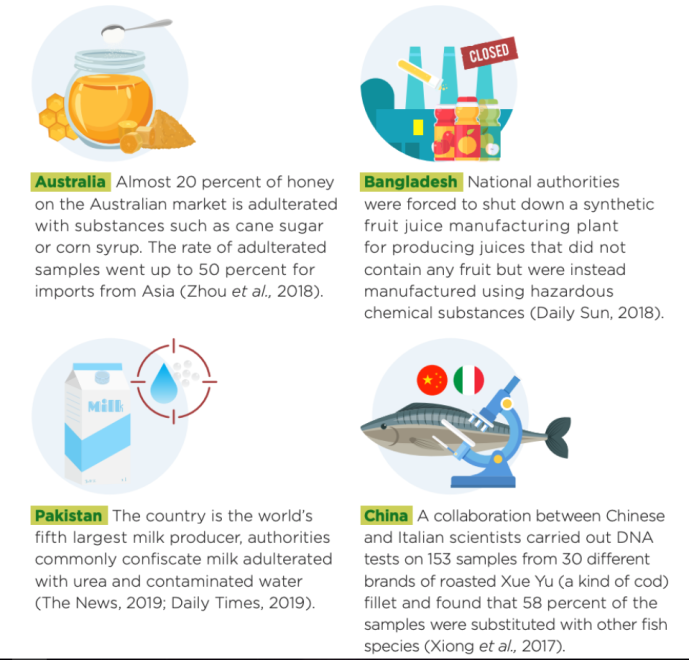A rising variety of consultants warn that meals fraud is quietly draining as much as $50 billion from the worldwide meals business annually. It could additionally put customers vulnerable to critical sickness.
In keeping with business insiders, blockchain technology may assist cease counterfeit and adulterated merchandise. But rolling out such techniques throughout advanced provide chains will demand massive investments and cautious planning.
Meals Fraud Hits Laborious
Food fraud means tricking patrons about what’s of their meals. It may be so simple as mixing low-cost oils into olive oil or as harmful as placing melamine in milk. Primarily based on studies, a 2008 milk scandal in China sickened over 300,000 infants.
As outlined by the UN Food and Agriculture Organization, meals fraud is the deliberate act of deceptive customers in regards to the true high quality or contents of the meals they buy.
Meals fraud might solely be a small slice of a $12 trillion sector, however it’s the identical dimension because the financial system of a rustic like Malta. Consumers lose belief and types undergo. Even trustworthy farms and retailers pay the worth when fraud scandals break.

Current instances of meals fraud that recorded throughout Asia and the Pacific. Supply: FAO
Blockchain Provides Transparency
Blockchain works like a public ledger. Each step within the provide chain might be recorded and locked in. In keeping with Walmart, utilizing Hyperledger Fabric to hint pork in China and mangoes within the US minimize monitoring occasions from days to seconds. Which means if unhealthy meat strikes down the road, it exhibits up nearly instantly.
As soon as information is on the chain, nobody can delete or change it. This provides patrons and inspectors a transparent document from farm to fork. Tech leaders say this type of open system can scare off fraudsters who thrive on secrecy.

In keeping with authorities, meals fraud is the intentional follow of misrepresenting what’s in a meals product—whether or not by including cheaper elements, swapping in lower-quality gadgets, or mendacity on labels—to trick customers and make extra cash. Picture: Gemini.
Price And Complexity Stand Agency
Even so, utilizing blockchain shouldn’t be low-cost or easy. Firms should pay for software program, {hardware}, and coaching. In addition they want sensors that feed information into the chain. If these gadgets break or lie, the ledger can have unhealthy information.
Oracles that hyperlink real-world occasions to blockchain might be hacked. Some companies fear about sharing too many particulars with rivals. Laws are nonetheless imprecise in lots of locations.
Getting everybody—from farmers to shippers to grocers—on the identical web page will take time and money. Primarily based on estimates, organising a big system may run into the thousands and thousands of {dollars} for large gamers.
Steps Towards Wider Use
Trade teams and companies like TE-Food and Provenance are rolling out pilot initiatives. They bring about collectively farmers, distributors, and retailers to check blockchain networks. Coaching classes are underneath method.
Some governments within the EU and Asia are speaking about clear guidelines for meals traceability. Specialists say that beginning small, with one product line or area, will present worth sooner. As soon as just a few success tales emerge, extra corporations may be part of.
The Street Forward
Meals fraud shouldn’t be going away. The instruments to struggle it are actual however expensive. Blockchain may finish the disaster whether it is used proper. Which means fixing gaps in cold-chain monitoring, fixing information islands, and getting clear guidelines from regulators.
It additionally means spending on good sensors, safe oracles, and powerful partnerships. If these items fall into place, blockchain will cease many fraud instances. Till then, the battle to guard meals and patrons will stay steep.
Featured picture from SafeFood, chart from TradingView
Editorial Course of for bitcoinist is centered on delivering completely researched, correct, and unbiased content material. We uphold strict sourcing requirements, and every web page undergoes diligent assessment by our crew of high know-how consultants and seasoned editors. This course of ensures the integrity, relevance, and worth of our content material for our readers.








